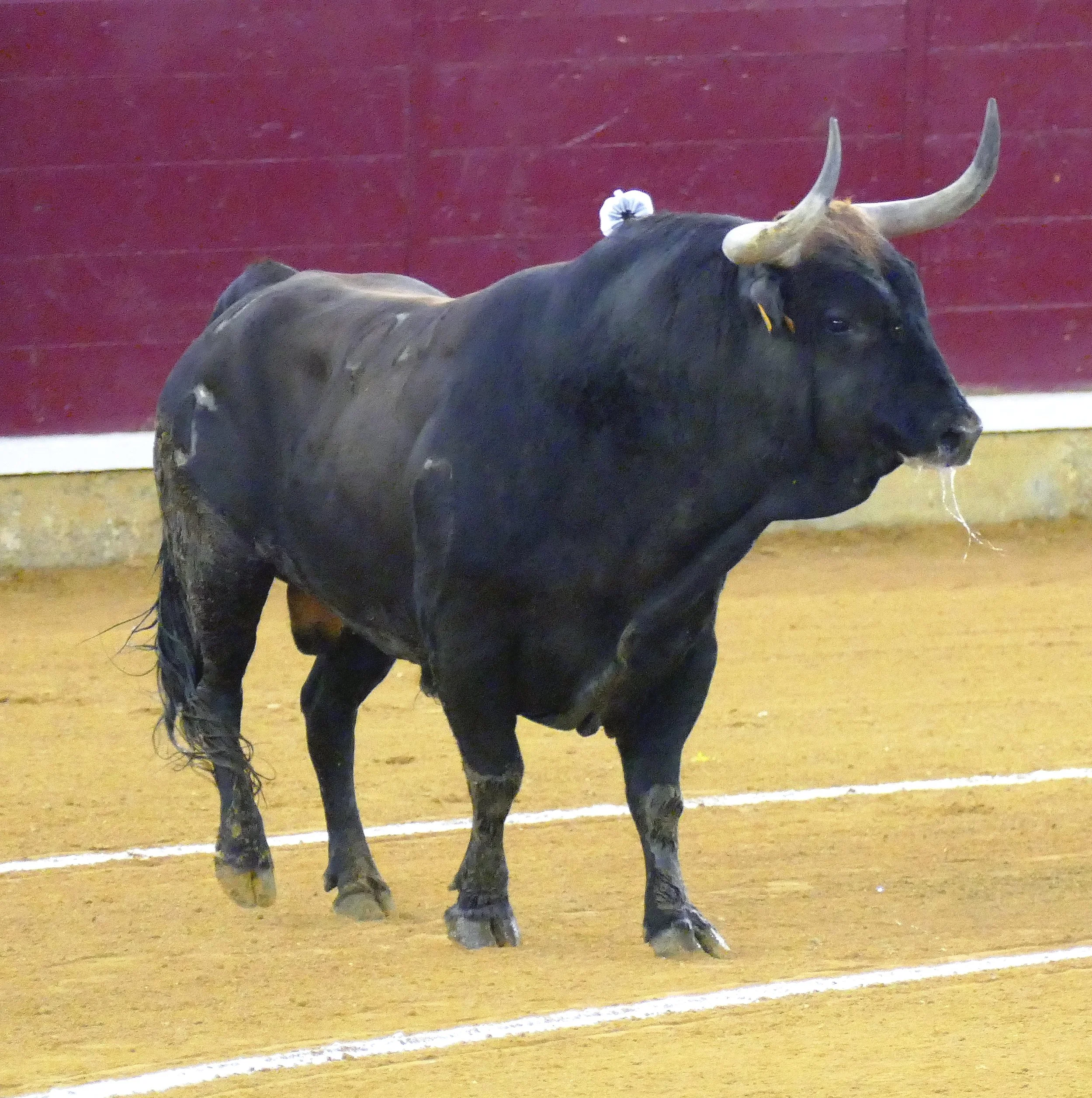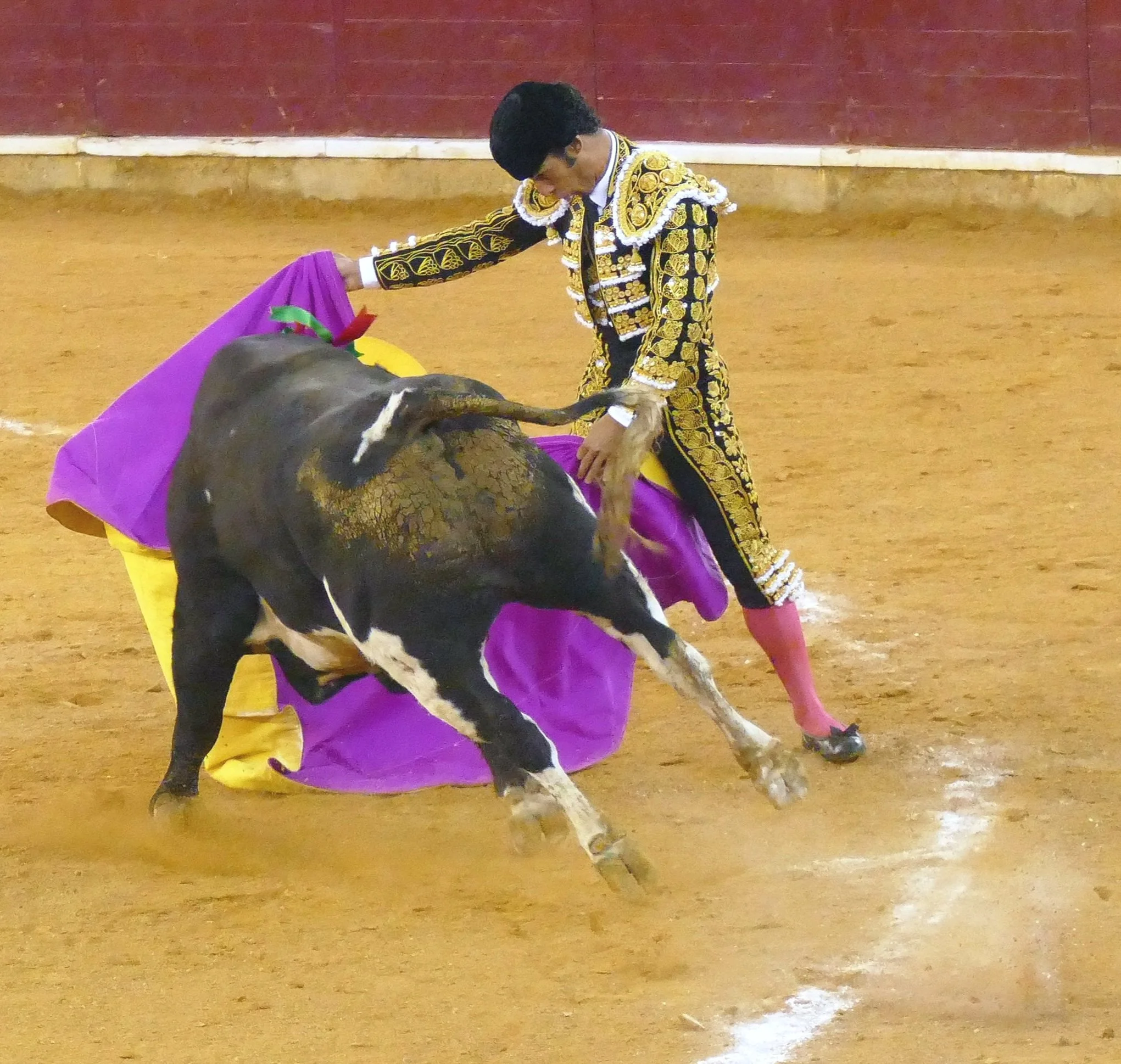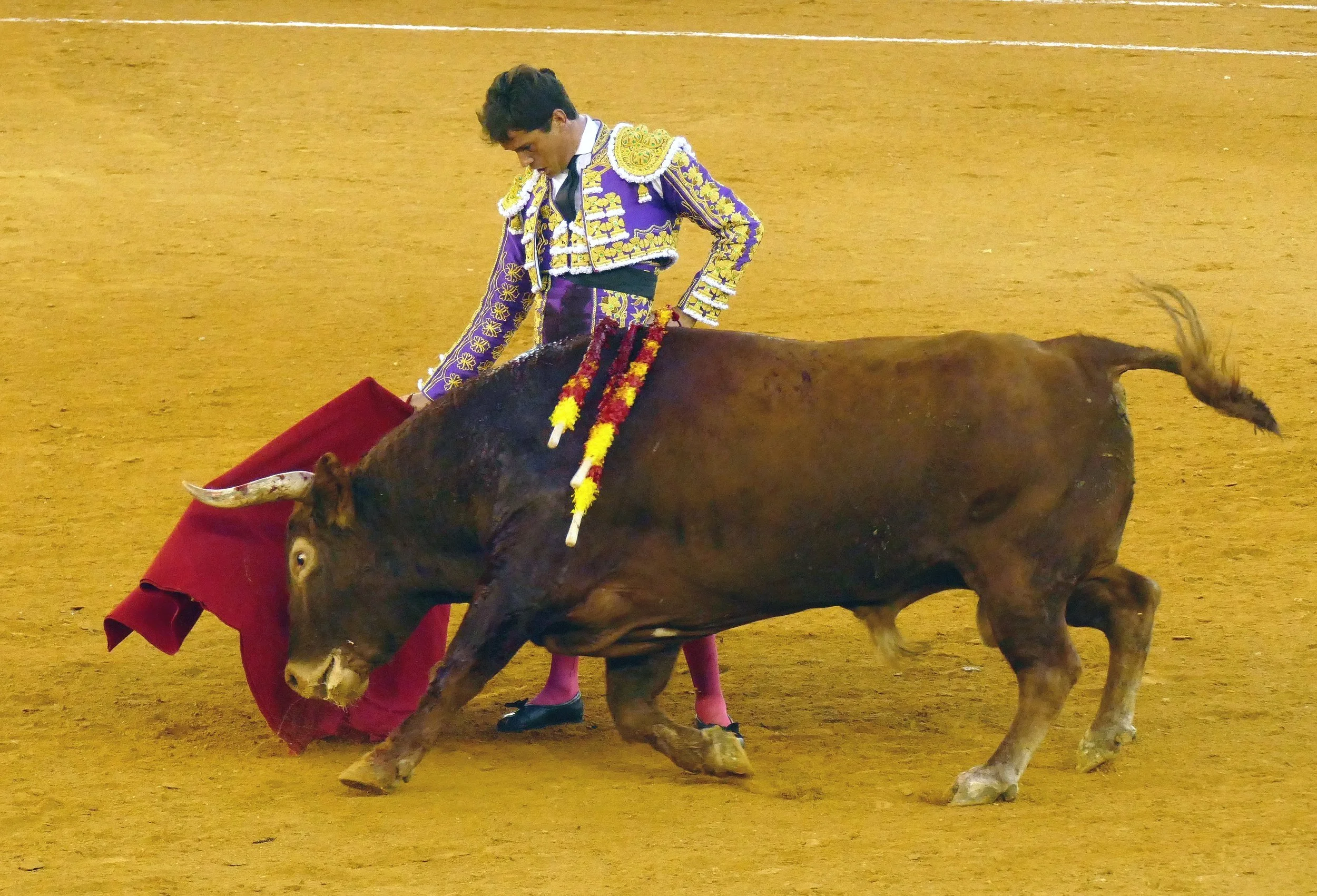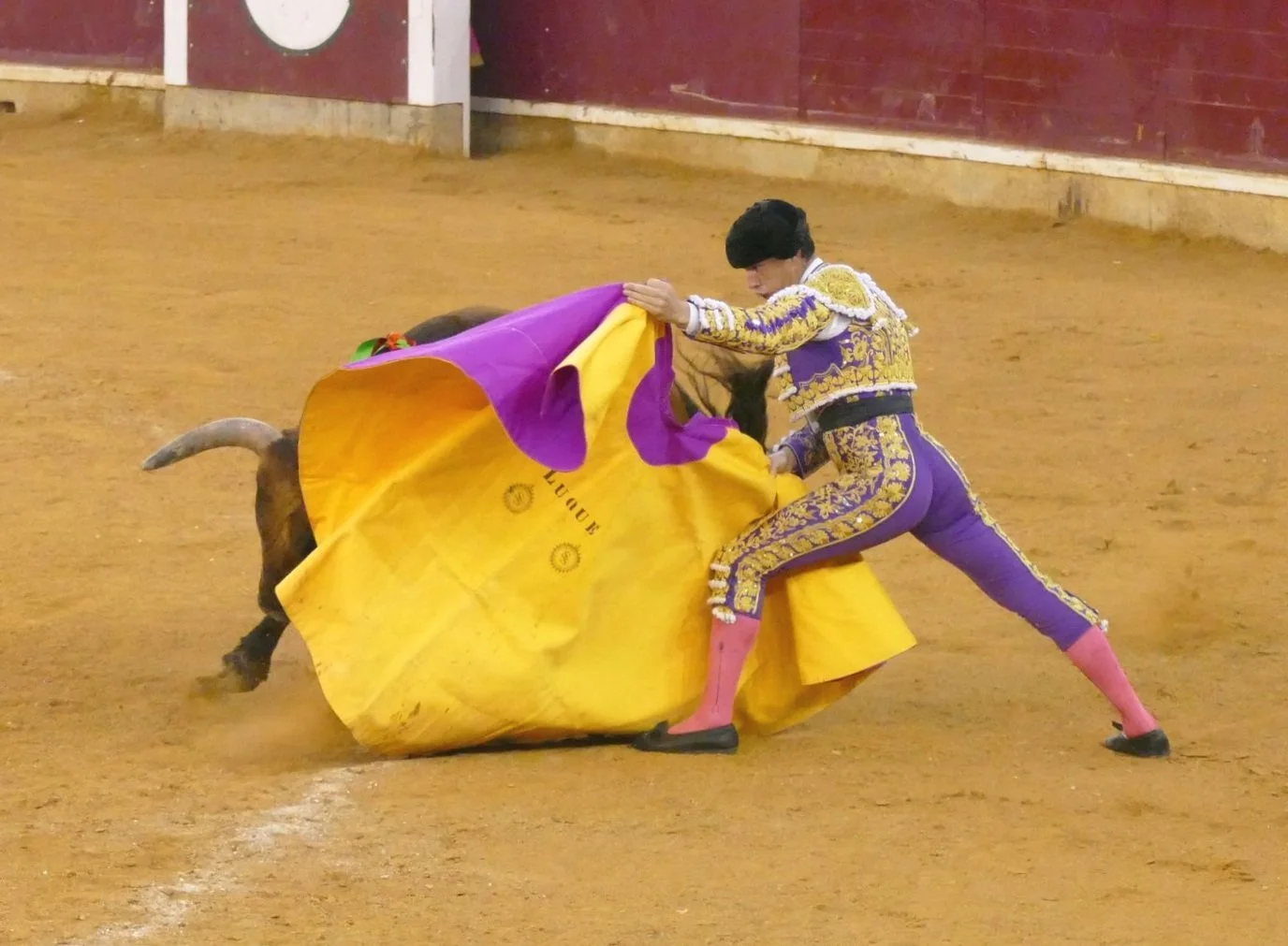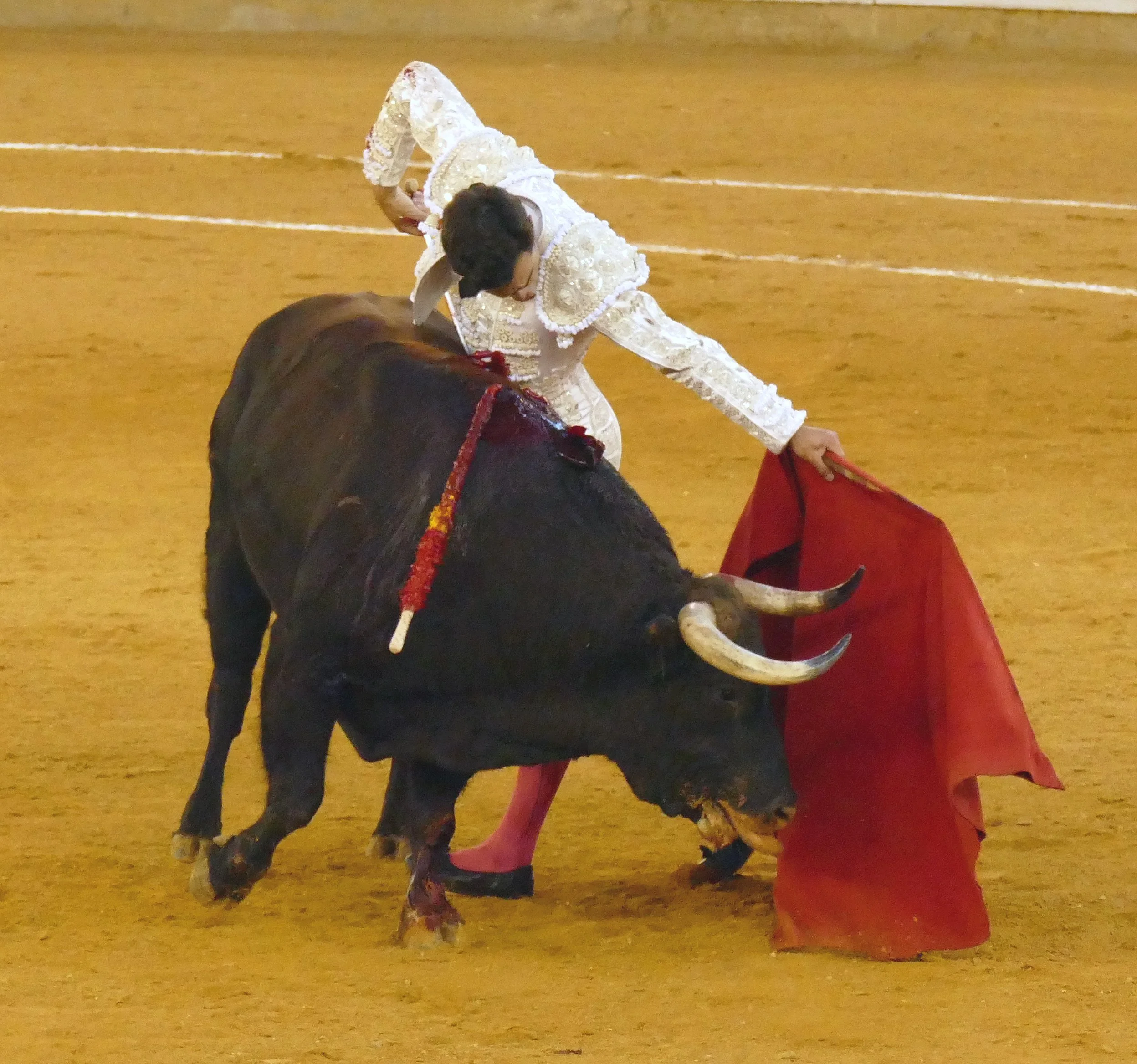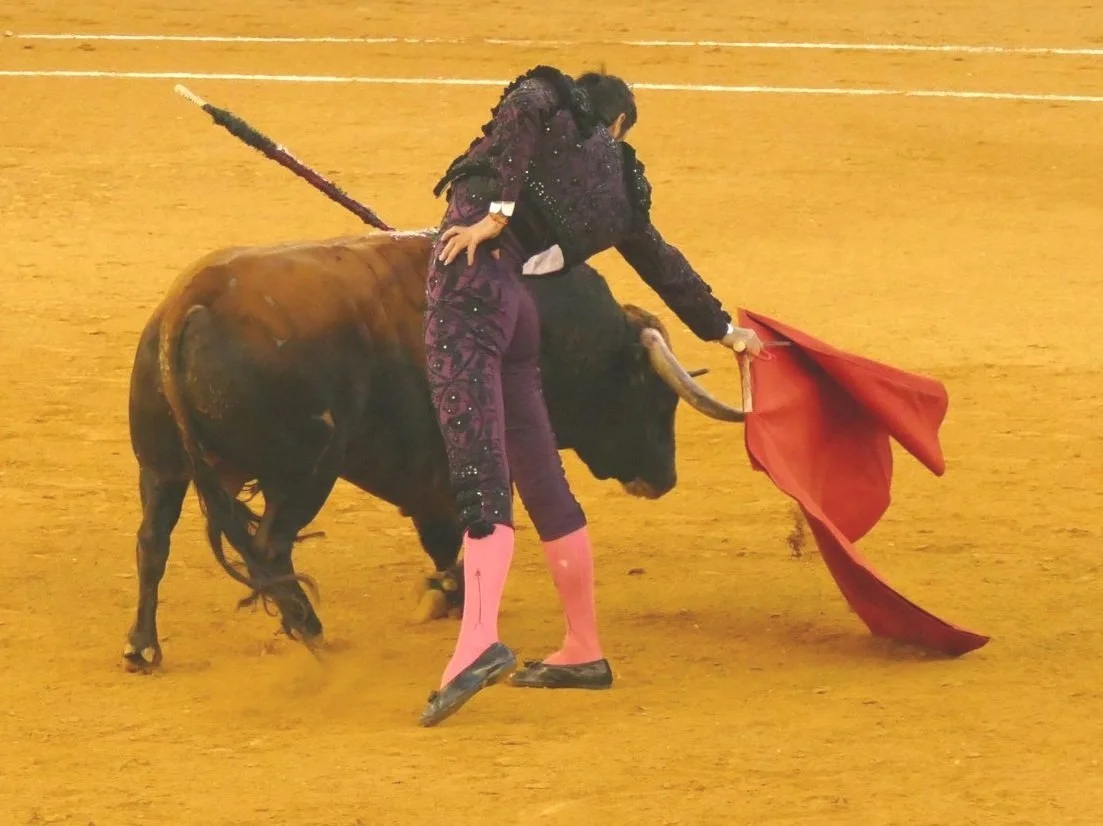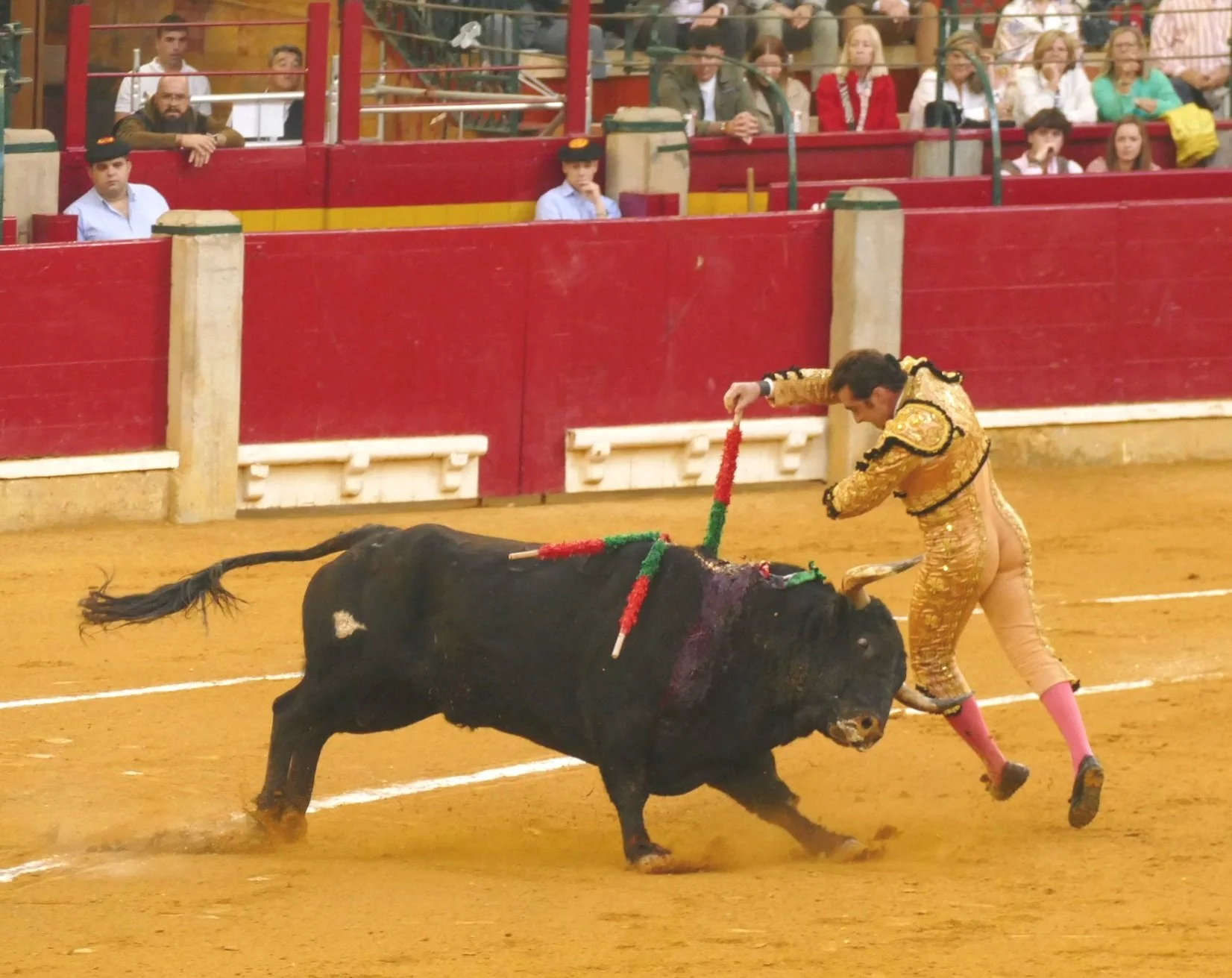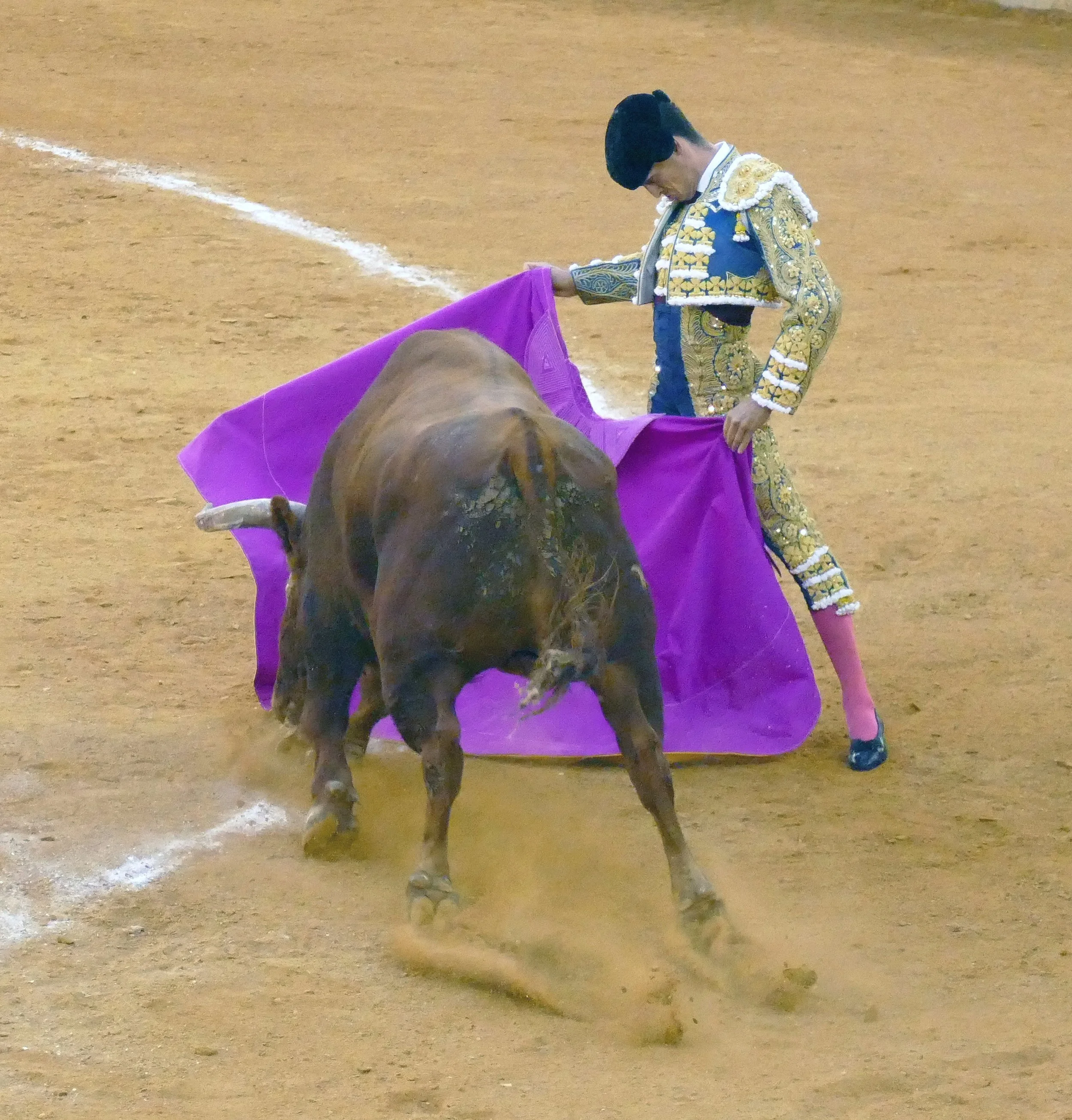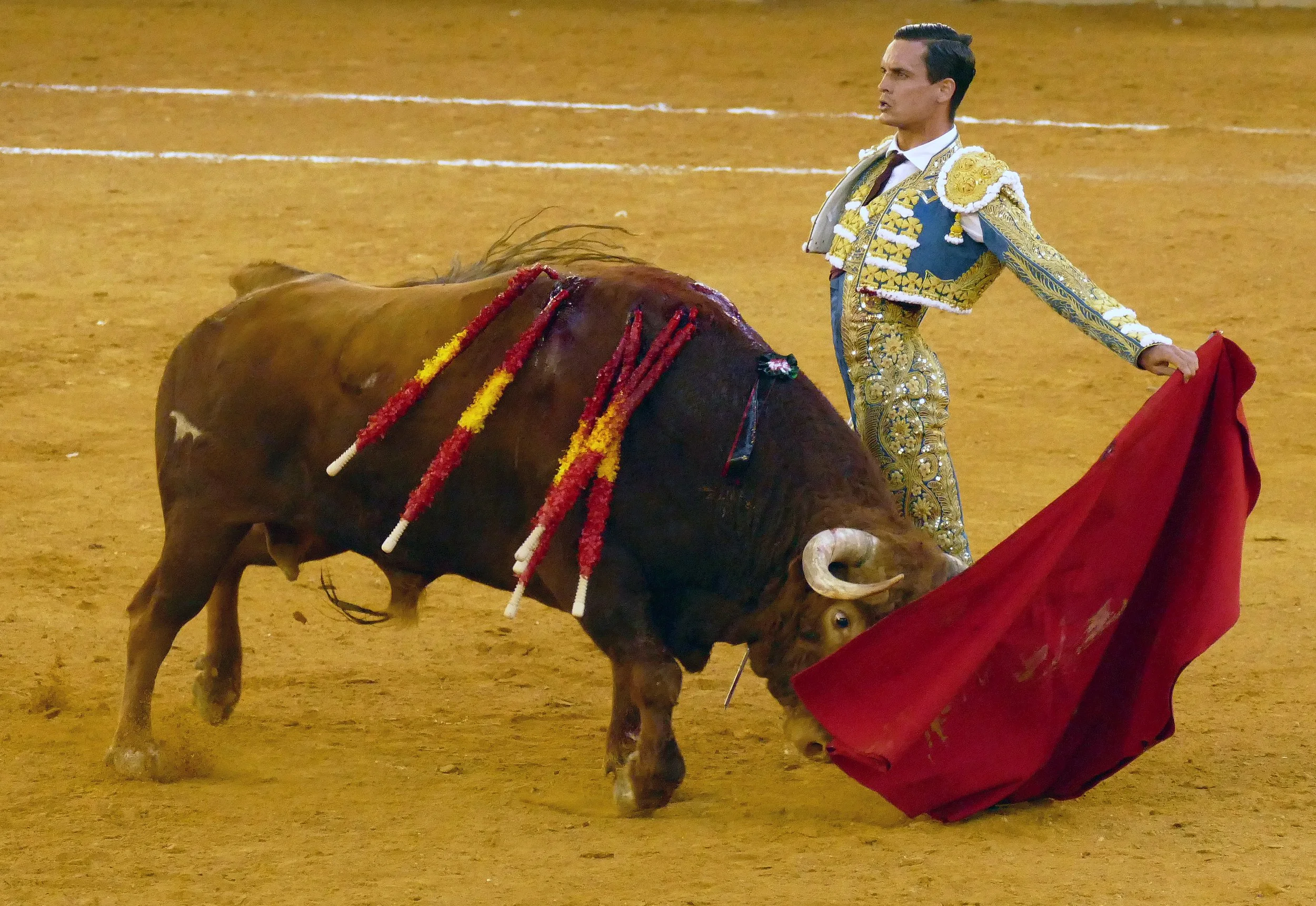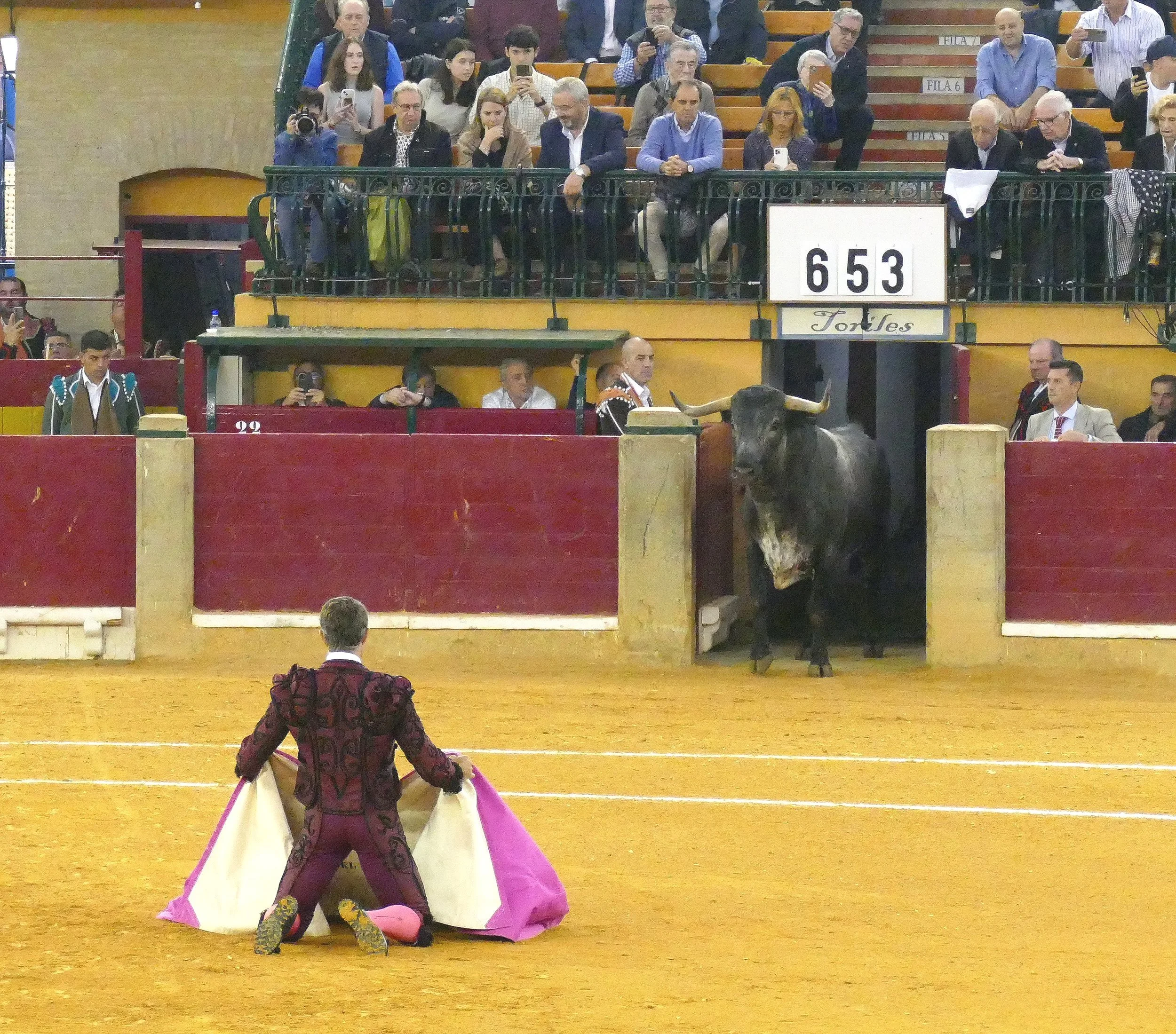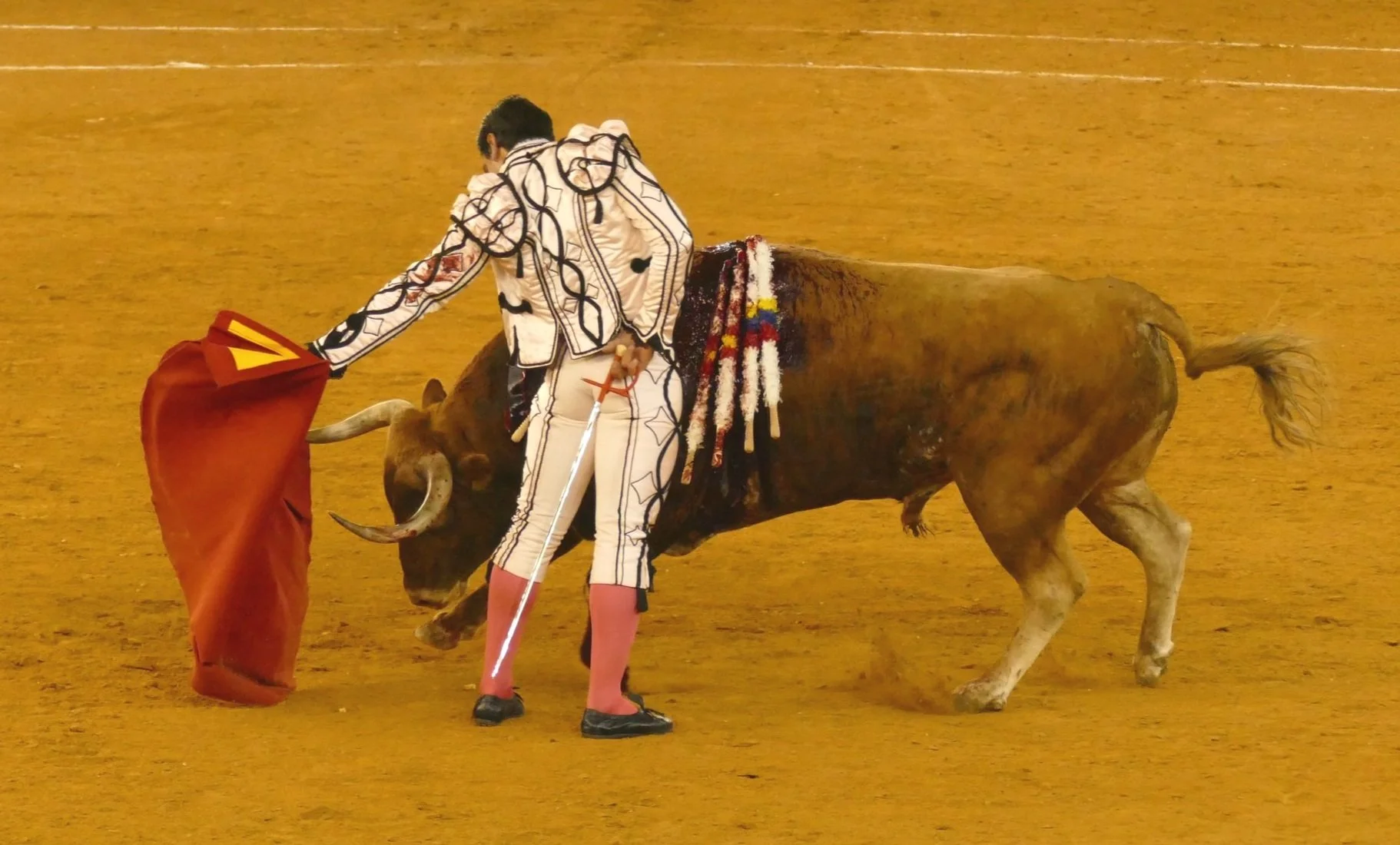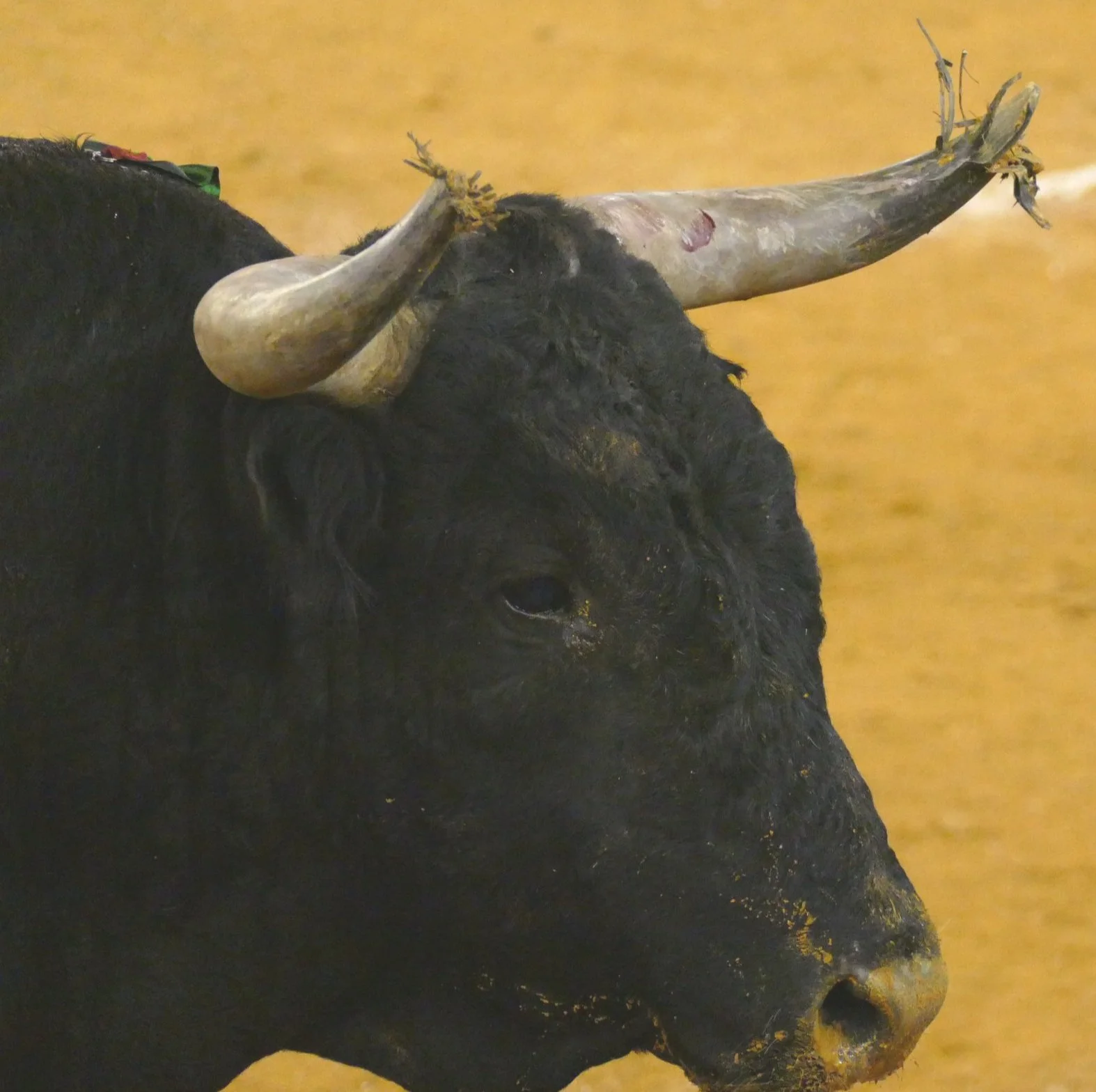Zaragoza’s los pilares (II)
Zaragoza, October 9: Different opinions in a corrida concurso
The regulations for corridas concursos say that the prize for best bull should go to the animal that shows best throughout its lidia, but particularly bearing in mind its performance during the suerte de varas. When Jock Richardson and I left Zaragoza’s Plaza de La Misericordia today, we both agreed that the best bull had been the opening entry from Concha y Sierra. Yet, later that evening, it was announced that the prize had gone to ‘Azulito’, from La Palmosilla, from which El Cid had cut the corrida’s only ear. But this animal had proved weak-legged. Yes, it charged to the picador thrice (the last time after the president had given up waiting and showed the handkerchief to change the tercio), but each time it had cast glances sideways before entering the peto. Granted, it did push well against the horse. However, a far more determined charge to the varilarguero was displayed by the wide-horned Concha y Sierra bull ‘Tigreso’, placed by Antonio Ferrera for four puyazos, and which was applauded on entry, en varas and en arrastre.
‘Tigreso’ from Concha y Sierra
Antonio Ferrera gives ‘Tigreso’ a natural
It was an afternoon of different opinions. There was a strong petition for one of ‘Tigreso’’s ears to be awarded to Antonio Ferrera, but the president (as I) thought otherwise. All in all, this was a poor afternoon by the extremeño. Yes, we had the visually interesting and baroque toreo for which Ferrera is known, and the matador taking the bull away from the picador himself rather than leaving the task to a peón, but, especially come the faenas, toreo de verdad was absent. There were some nice derechazos in that first faena, but also an awful amount of leaning away from the vazqueño’s impressive horns. The estocada was well-placed, which is more than can be said for the three pinchazos and a half sword given running round the head of his second animal, from Peñajara de Casta Jijona. This bull also participated in a lengthy four entries to the picador’s horse, hardly pushing once it reached the peto and twice catching its horns in the sand as it came away, a feature that, bewilderingly, drew whistles from some in the crowd. In the faena (following merited applause to Ángel Otero and Manolo de los Reyes en banderillas), the bull cut in on the matador early on and, after that, Ferrera wanted very little to do with it, and very little was the result. A controversial vuelta after the first bull was followed by silence after his second.
Zaragoza witnessed another strong post-comeback performance from El Cid
Manuel Jesús El Cid was triunfador de la tarde. His tall first bull, from Fraile y Martín after the Pablo Mayoral toro originally announced for this corrida was rejected by the vets, spent the opening minutes of the first tercio looking over the barrera, keen to find a way out, and was dangerously defensive in the faena, giving the sevillano little option other than to seek a quick kill; there was a metiscaca, pinchazo and descabello before the dead bull’s departure was whistled. Manuel dedicated his second, the palmosilla, to the public and was soon into exquisite linked derechazos, some of these extended into complete circling of the matador. Passes with the cloth in the left hand were generally less impressive, El Cid soon reverting to the right following just one good tanda of naturales. After a slightly tendida estocada, El Cid was awarded the bull’s ear, at the vuelta’s end the veteran grasping some of the arena’s sand and holding it to his lips before letting it fall away in a gesture which, given the empresas’ continued reluctance to contract the sevillano, may turn out to mark the matador’s final appearance in this plaza.
The day’s other matador – how sensible to put three veteranos on in a corrida concurso – was Morenito de Aranda, coming to Zaragoza on the back of a strong 2024 temporada. His first bull, a fine-looking galache, showed some lameness on entry and was given little opportunity to overcome it before being devuelto in favour of a sobrero from Salvador Gavira García. As this animal (which came in with a dreadfully escobillado left horn) was fuera del concurso, Morenito engaged in a proper capework sequence of verónicas and media. The animal received just two puyazos and its faena was dedicated to the public. It began well enough with derechazos, the band soon striking up, but then the bull decided it just wanted to walk alongside the barrera, frustrating Morenito’s attempts to engage it further. Two poor pinchazos were followed by an early decision to descabellar (pitos). It all ended to silence for both man and bull.
Morenito de Aranda in a verónica to the galache, later devuelto
The burgalés’s other animal was another from Salvador Gavira García, this time part of the competition. He attempted to meet it a portagayola, only for the bull to wander off to the side; two largas cambiadas de rodillas by the boards had to suffice instead. There was a near cogida in the capework before the animal was positioned and entered submissively for four extremely light puyazos, the picador, Héctor Piña, winning applause and being subsequently judged as the corrida’s best horseman. Morenito’s second dedication to the tendidos was followed by a lengthier faena, the passes given with style but somewhat rapid in execution, and the bull failing to humillar and worsening in its behaviour. An estocada that dropped the bull almost immediately resulted in a very small petition for an ear before Morenito took a vuelta.
October 10: Magic from two maestros
One of the local papers (was it the same one that had earlier, and very wrongly in my view, described the feria’s proposed carteles as ‘monochromatic’?) criticised today’s cartel as “lacking harmony”, but to my mind the combination of Miguel Ángel Perera, Daniel Luque and Tomás Rufo, with bulls of Zacarías Moreno, held a lot of promise. Promise that was largely fulfilled.
The first torero to taste success was Daniel Luque with an interloper, anovillado, bull from Álvaro Núñez, one of the Zacarías Moreno animals having failed to pass the vets. There was just one proper verónica before the animal was given two varas, the first light and the second more forceful. It was clear in banderillas, Iván García and Jesús Arruga receiving deserved applause, that the bull retained a strong charge. After dedicating to the plaza, Daniel took the animal out to the centre of the ring with a beautifully-constructed sequence of pases de la firma and trincherazos. Excellent series of derechazos and naturales followed, with one muletazo turning into a near-endless pase de pecho, the bull being taken slowly round Luque’s body in a complete circle. Some in the crowd were on their feet well before the sevillano engaged in luquesinas. What a shame the kill was less than perfect, Luque having to stretch out from the bull’s side to place the sword in to its hilt. This reduced my petitioning to one ear, but most in the crowd felt two were merited and two were given, with the bull (which had been protested on entry but had proved a fine accomplice) applauded en arrastre.
Daniel Luque with a relaxed derechazo to his first bull…
… and caping his second
The sevillano’s second faena was in marked contrast to his first, for this bull, given some tight, half-kneeling verónicas and a larga to start with, was no easy animal, as banderillero Juan Contreras found out when it overran him in an opening pair of sticks and inflicted a cornada grave in a buttock. There were further half-kneeling passes to begin the faena before Luque gradually engaged the animal, which had an initial tendency to cut in and shorten its charge, in derechazos. Calls from the crowd for music had the matador showing his disagreement, and the same occurred when the band started playing. As the faena continued without music, so Daniel mastered his opponent, producing some fabulous series of templados derechazos and naturales, closed with chest passes, and there was an attractive sequence of the matador flicking the muleta’s far corner backwards and forwards in front of the bull before bringing it forward in a pase. What a shame the kill again left something to be desired – a better entry this time, but disappointing placement. Many in the crowd, though, had been on their feet at points in this faena and most petitioners kept waving their handkerchiefs until two ears had been awarded, while there were differing opinions of the bull en arrastre. Despite the problematic estocadas, I reckoned this was the most accomplished showing I’ve attended by Daniel Luque.
The other triunfador was Tomás Rufo. He began his afternoon with some lovely, slow, verónicas, but his bull proved hard work in the rest of that tercio, running off after capotazos and also from its second vara. Nevertheless, the faena that followed was very good, begun with half-kneeling passes, then, in the centre of the ring, series after series of excellent derechazos and naturales (one templado natural in particular seemed almost endless), completed with curving pases de pecho or desdén remates. The faena’s immaculateness dissipated somewhat as the bull slowed, but Tomás produced a fine closing series of manoletinas before going in with the sword. Alas, the result was a bajonazo, but there was still a strong petition for two ears, one of which was given.
Always curving: Tomás Rufo in an astonishing natural to his first bull (above) and (below) closing a derechazo to his second
There was some mixed opening capework to the day’s last animal – a verónica given on one knee, others with the feet together and a half-kneeling remate – and a more consistent series of lances con pies juntos in between the animal’s two light puyazos. There followed an outstanding pair of sticks from Fernando Sánchez and a couple of good pairs by Sergio Blázquez, the two earning an ovation. Rufo dedicated to the plaza, then got down on his knees for a superb and lengthy series of derechazos, the muleta kept low and the bull passing closely. On his feet, the toledano, who is great at communicating both determination and enjoyment in his toreo, produced some exquisite series of curving muletazos, the high number of passes in each series and their demanding nature requiring the bull to be rested in between each intense encounter. There were some narrow escapes at the end of these tandas and how he emerged unharmed on one of these I will never know. The faena, which had some in the crowd on their feet, was relatively short as the bull opted for the barrera and Tomás decided not to try and extend things, instead delivering a committed estocada (at last this afternoon!) which felled the bull and led to the award of two ears.
Miguel Ángel Perera
Miguel Ángel Perera was out of luck today. He was on his way to an ear in his opening faena up until his swordwork – an estocada trasera and three descabellos. Earlier, after some fine banderillas from Fini and a brindis to the spectators, there had been some strong linked derechazos, but it all ended to an aviso, palmas for the bull and silence. His other bull possibly had a visual problem – at one point it ran past the banderillero attempting to place sticks in it in favour of chasing the other banderillero on the far side of the ring. Certainly, Perera spotted its difficulties early on. The tercio de varas was chaotic, with two entries to the reserve picador and a further two to the correct horseman, although one of these was while the picador was on his way out of the ring! A faena de aliño followed, resolved with a pinchazo and a bajonazo, Perera finding an audience divided over his efforts, while the bull was whistled out of the plaza.
National taurine critics were soon describing this afternoon as one of the corridas of the year, so exceptional were Luque’s and Rufo’s performances.
October 11: Protests and Heroics
In the build up to this corrida, there was much speculation as to who would take the place of the injured Borja Jiménez. The obvious replacement was Fernando Adrián, but on October 10 it was announced he was still recovering from injuries received during his Madrid mano a mano with the sevillano. Some who’d been here throughout the feria reckoned Jorge Isiegas deserved another opportunity in front of his home crowd, but he had split with his manager (and Zaragoza empresa) Carlos Zuñiga after his earlier Pilar appearance, so his return seemed unlikely. Perhaps Daniel Luque or Tomás Rufo could be persuaded to stay on for a second afternoon after yesterday’s triumphs? On the morning of the corrida, the substitution was announced – David Fandila El Fandi.
Zaragoza’s aficionados made their views on the substitution loudly known immediately after the paseíllo was terminated following a minute’s silence for the deceased journalist Salvador Asensio and the playing of the national anthem, and the protests continued during the lidia of the first of today’s El Pilar bulls, which made a nice leap over the rayas as it entered the arena. El Fandi is now the epitome of the has-been torero – bloated, red-faced, his traje sagging in all the wrong places. His toreo was always based on his athleticism, and that feature is retained to some extent; here is toreo with the feet, rather than the arms, but, faced with animals that charge, he can no longer sustain this approach and any control he may have had over his bulls is lost. Today, he experienced a number of close shaves which made one fear for his safety unless he retires soon. He greeted his opening bull with two largas cambiadas de rodillas, further capework close to the boards and a distant media verónica, back on his knees once more. His quite of chicuelinas and a larga, then taking the bull to the correct position for the picador with the cape in one hand was impressive, and, following a brief quite from Paco Ureña, the crowd enjoyed El Fandi’s banderillas – two pairs al cuarteo and a closing pair al violín. After dedicating to the spectators, the granadino was back on his knees once more for opening derechazos, very distant passes compared to those given yesterday by Tomás Rufo. El Fandi’s awful habit of closing series with a molinete instead of a pase de pecho is now modified to a molinete followed by a chest pass. But the protests grew as he found himself unable to end series cleanly and then achieved absolutely nothing with the cloth in the left hand. The faena was concluded with an estocada contraria, El Fandi’s killing skills not deserting him, and the matador received a división de opiniones while the bull was, rightly, applauded en arrastre.
Banderillas al violín from El Fandi
El Fandi gave some walking chicuelinas and a larga remate in front of the picador to his second bull, but was lucky to escape a goring as he tried to leave the animal there. A quite of navarras turned defensive too. The tercio de banderillas followed the same format as before and the faena to an animal that was cutting in hadn’t got far before a loud crack announced that the bull had broken a foreleg. A frustrated El Fandi killed it with an estocada and three descabellos, receiving silence.
A somewhat morose looking Paco Ureña was almost absent today. It wasn’t entirely his fault – his second bull’s mobility was damaged en varas and the president refused to change an animal that could only jump forward on its forelegs, its head moving up and down accordingly in the muleta. The lorquino tried to make up for things by conducting the faena primarily with the left hand, but the bull collapsed completely a couple of times, little could be achieved and the crowd’s protests towards the president grew. A poor pinchazo led to a successful descabello, the lidia ending with a bronca for the president, pitos for the bull and silence for its matador.
Paco Ureña
Earlier, things had got off to a bad start when Paco lost his cape in the opening capotazos, hightailing it for the barrera, and then returned to give ground in lances. David Galván showed what could be achieved with this animal, given one light and one heavy puyazo, by executing an impressive quite of chicuelinas and larga. Ureña duly dedicated to the plaza, only for his faena, conducted mainly on the left hand following some initial strong derechazos, to prove patchy in quality, although the matador’s quietud marked a strong contrast to El Fandi’s preceding faena. Paco wasn’t helped by the bull’s weakening, linked passes proving increasingly difficult despite the animal being rested in between series. Ureña killed with an estocada, receiving an ovation.
David Galván was the afternoon’s triunfador, winning an ear from his first bull. The gaditano’s southern roots were particularly evident as he gave verónicas, a media verónica and a revolera in the Sevillian style to his opening animal, which lost part of a horn in the peto, leading to whistles. David dedicated its faena to the public nevertheless, going on to produce varied muletazos from the opening half-kneeling derechazos to the closing poncinas. The cloth was held mainly in the left hand, some of the naturales being particularly strong, with the matador stretching out passes to their fullest extent. There was a farol at one point, and Galván showed a liking for giving passes while mirando al tendido. He killed with a good three-quarter estocada, many in the crowd petitioning for a second ear.
David Galván showed well with both capote (above) and muleta (below)
Galván’s performance with the day’s final El Pilar was truly heroic. This was a dangerous animal which caused problems from the start, both David and Paco Ureña having their capotes snatched from their hands and Galván’s banderilleros having to enter six times in order to leave three banderillas in the bull’s hide (the ‘aficionados’ in the plaza still criticising the president for changing the tercio with only this number of rehiletes in place). In the faena, the bull continued its cutting in tendencies, clearly looking for the man, but David persisted with it nevertheless, suffering a horn blow to his head at one point. After managing to bring off some respectable muletazos on either hand, he ended with an honest and effective estocada, getting caught in the process, but emerging uninjured from the cogida. After receiving a minority petition, Galván took a vuelta, the bull having been dragged out to pitos.
October 12: An awful ‘miurada’
“Este es peor que mal,” said a neighbour of mine during today’s corrida goyesca, and I couldn’t disagree, this ranking as one of the worst corridas I’ve attended in some 55 years of watching los toros. Prior to the puerta de chiqueros opening, the miurada had already been depleted by Zaragoza’s veterinarios, today’s second animal being from Concha y Sierra (another good-looking animal that behaved well in the faena, to complement the bull from the same ganadería that performed impressively in the feria’s corrida concurso). By the corrida’s end, another two miuras had proved weak-legged and in need of substitution. But it wasn’t just the bulls that were so awful…
Manuel Escribano faces the opening miura
One of the most impressive sights of today’s disastrous affair was that of the opening tall and typically large-boned miura coming out from the toril in front of Manuel Escribano, awaiting it a portagayola. But that opening larga cambiada de rodillas was the only lance of note. After the bull entered to the picador three times, banderillas were shared with Jesús Enrique Colombo, Escribano placing the last pair al violín. Although the faena was dedicated to the public, the bull had little charge, particularly on the left horn, and showed sentido, Manuel being limited to risky single passes before killing with an estocada and three descabellos. A further greeting a portagayola followed with the sevillano’s second bull, Manuel throwing himself on the ground to avoid its charge. Verónicas and a scrappy media verónica and revolera followed. His banderillas were poor, only placing half of the second pair and the matador having to stretch to place the banderillas in his closing pair al quiebro. The faena was a lengthy one and featured some decent derechazos, but one had the general feeling that Manuel had decided to simply go through the motions this afternoon. He finished with a pinchazo and estocada caída, hearing an aviso. The miura was applauded en arrastre and Escribano received applause too, taking saludos.
Esaú Fernández came to this first class plaza with a growing reputation of performing well with toros duros in lesser bullrings. He had certainly improved a lot since my last viewing of him some years ago. He too opted for portagayola starts to his lidias, although his opening bull (from Concha y Sierra) went off along the barrera on entry, Esaú having to make do with two largas cambiadas de rodillas beside the toril instead before losing the capote to his opponent. The bull went well to the picador for two light puyazos and Fernández produced a respectable faena, holding the muleta low on both the right and left hand, although efforts to link were thwarted by the bull’s tendency to hook at the end of passes. Any chance of an ear was lost with a crosswise estocada that came out the bull’s side. A descabello was followed by applause for the bull and a division over the matador’s merits.
Esaú Fernández in a pase de pecho to his Concha y Sierra bull
Indeed, this was a bad-tempered afternoon in the tendidos, one section of the crowd apparently unhappy at both Fernández’s and Colombo’s inclusion in the cartel. Esaú executed a decent lance a portagayola with his second bull, but didn’t recover from the pass sufficiently, having to drop the capote and run from the miura, which thereafter was caped well by Antonio Chacón. The bull, having entered to the picador a second time from a distance, was devuelto en banderillas and replaced by an animal from Salvador Gavira García, given two light pics. In the faena, Fernández achieved some linked passes but, I felt, inhibited the bull by keeping it too close. A poor sword and descabello led to palmas for the bull and Esaú taking saludos to another division of opinions.
Jesús Enrique Colombo seemed out of his depth all afternoon. He stepped back in the capework to his initial miura, soon devuelto, but was more confident with the Peñajara substitute, producing verónicas with the feet together, a media verónica and revolera. The bull made a good second entry to the picador, charging in from the centre of the ring, and the Venezuelan performed a nice quite of delantales, closed with a serpentina. Banderillas were shared once more, to no great effect. In the faena, the bull was so difficult to bring forward that Colombo would cross the line of charge only to then find himself compromised when the animal turned back towards him. An estocada caída was followed by silence for both parties.
Colombo with his Peñajara bull
The final miura of the day was a ridiculous 699 kilos and proved weak from the outset, falling to the ground after its first puyazo, and very soon carried two appallingly escobillado horns. Colombo tried to lighten the despondent atmosphere with banderillas, only for more protests to erupt - protests that continued when he looked to dedicate the faena to the plaza. He then embarked on a lengthy faena, nursing the short-charging bull throughout to keep it on its feet and not always succeeding. A bajonazo brought light applause and three hours of disappointment to an end.
The horns on the third and final miura

